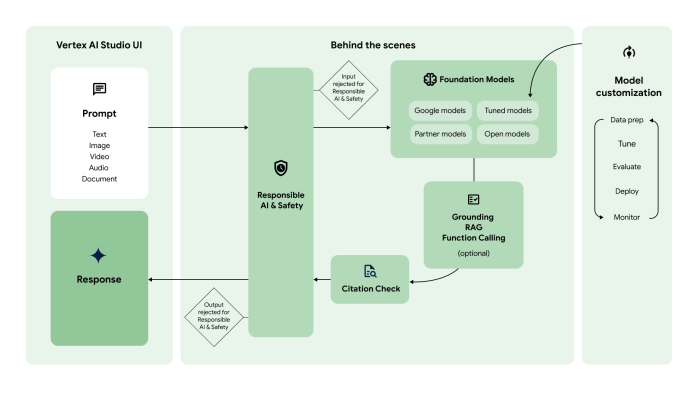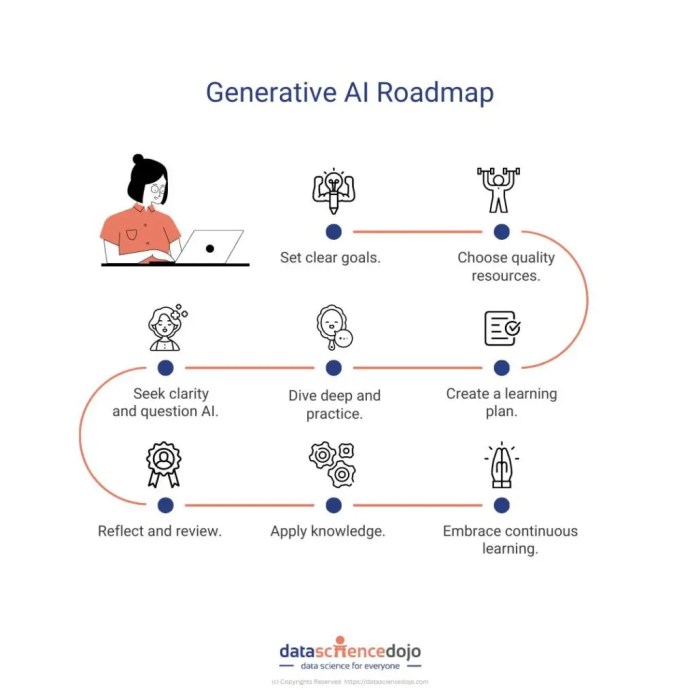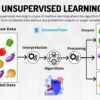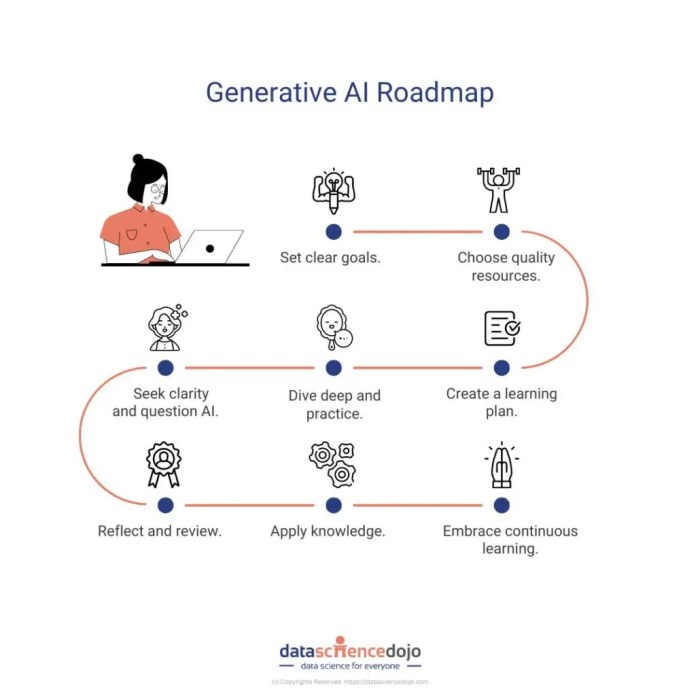Google is using generative AI to create better art selfies, ushering in a new era of self-expression. Imagine transforming ordinary selfies into stunning works of art, using AI to enhance and personalize your image. This innovative technology blends the familiar concept of a selfie with the power of generative AI, offering exciting possibilities for artistic expression and self-representation. The process involves using AI models to interpret and translate input, such as photos, descriptions, or styles, into unique and personalized art selfies.
This new method presents both exciting opportunities and potential challenges, impacting how we perceive and represent ourselves in the digital world.
This exploration delves into the process of generating art selfies using generative AI, comparing them to traditional selfies, and examining the ethical considerations and future trends surrounding this emerging technology. We will discuss the different types of AI models used, the role of user input, and potential biases within the AI. Furthermore, we will look at examples of AI-generated art selfies and analyze the artistic styles and techniques employed.
Introduction to Generative AI in Art Selfies
Generative AI is rapidly transforming various creative fields, including art. This powerful technology uses algorithms to learn patterns from existing data and generate new, unique content. It’s no longer limited to simple image modifications; it can now create entirely novel pieces of art. This innovative approach has profound implications for art selfies, allowing for unprecedented levels of customization and creative expression.Art selfies, traditionally limited to capturing a person’s self-expression through photography, are now poised for a significant evolution.
Generative AI empowers users to not just take a picture but to manipulate and enhance it, incorporating elements of artistic style, textures, and even fictional environments into their self-portraits. This technology opens up possibilities for artistic experimentation and self-discovery, going beyond the constraints of traditional photography.
Generative AI Techniques in Art Selfies
Generative AI techniques are revolutionizing how we create and interact with art. By learning from vast datasets of images, these algorithms can generate new imagery that mimics various styles, from photorealism to abstract expressionism. This ability to synthesize artistic elements is particularly relevant to art selfies, enabling users to transform their self-portraits in innovative ways.
Potential Benefits and Drawbacks
Generative AI offers numerous benefits for art selfies. Users can experiment with different artistic styles, enhance their appearance with creative filters, or even create entirely fantastical portraits. The possibilities are endless. However, ethical considerations and potential misuse need careful consideration. The ease of creating altered images could lead to the spread of misinformation or the appropriation of artistic styles without proper attribution.
Furthermore, the potential for algorithmic bias in the training data could result in skewed or stereotypical portrayals.
Techniques for Enhancing Art Selfies
The following table Artikels some generative AI techniques and their potential impact on art selfies.
| Technique | Description | Example | Potential Impact |
|---|---|---|---|
| Style Transfer | Transferring the artistic style of one image to another. | Transforming a selfie into a painting style like Van Gogh’s. | Allows users to explore different artistic aesthetics and experiment with their self-expression in unique ways. |
| Image Enhancement | Improving the quality and details of an image. | Adding depth of field or removing blemishes from a selfie. | Provides users with more control over the final aesthetic of their art selfie. |
| Compositional Modification | Altering the arrangement and elements within an image. | Adding a background or changing the perspective of a selfie. | Enhances creativity by providing new compositional choices and a wider range of creative opportunities. |
| Object Insertion | Adding virtual objects or elements to an image. | Inserting a futuristic cityscape behind a selfie or adding fantastical creatures. | Provides users with a means to incorporate imaginative elements and create more dynamic and compelling self-portraits. |
Exploring the Process of Generative AI Art Selfies: Google Is Using Generative Ai To Create Better Art Selfies
Generative AI is rapidly transforming the way we create art, and the selfie space is no exception. This technology allows for the generation of unique and personalized art selfies based on various inputs, opening up a world of creative possibilities. From simple photos to detailed descriptions, users can now craft artistic representations of themselves with surprising ease and creativity.This exploration delves into the specifics of how generative AI models work to produce art selfies, detailing the input requirements, model types, and the variety of outputs achievable.
Understanding these steps empowers users to harness the potential of this technology and generate truly personalized and artistic representations of themselves.
Input Requirements for AI Art Selfies
The success of generating an art selfie relies heavily on the input provided to the AI model. This input can vary significantly, from simple images to complex descriptions and stylistic preferences. The AI model interprets this input to create the desired output, so careful consideration of the input is crucial.
Different Types of Generative AI Models
Several types of generative AI models are used to create art selfies. These models differ in their architecture and the nature of the input they can handle. The most common types include:
- Generative Adversarial Networks (GANs): These models involve two neural networks competing against each other. One network generates new data, while the other network evaluates the generated data. This interplay allows the GAN to learn to produce realistic and high-quality outputs.
- Variational Autoencoders (VAEs): VAEs learn a compressed representation of the input data. This allows them to generate new data that is similar to the training data. They are often used for tasks requiring more control over the generated output.
- Diffusion Models: Diffusion models are another class of generative models that have recently shown remarkable success in generating high-resolution images. They progressively add noise to an image and then learn to remove the noise, enabling the generation of images from random noise.
Examples of Input Types and Their Outputs
The quality and characteristics of the generated art selfie are highly dependent on the input. Here’s a table illustrating various inputs and their potential outputs:
| Input Type | Description | Example | Output Characteristics |
|---|---|---|---|
| Photo | A standard selfie image. | A selfie of a person smiling. | The generated art selfie will likely be an artistic interpretation of the original photo, potentially adding stylistic elements or altering the colors. |
| Text Description | A detailed description of the desired style and features. | “A vibrant, abstract portrait of a person in a flowing dress, reminiscent of Van Gogh’s style.” | The generated art selfie will closely reflect the style and features described, potentially creating a surreal or stylized representation. |
| Style | A specific artistic style (e.g., Impressionism, Surrealism). | “Generate an art selfie in the style of Klimt.” | The output will be strongly influenced by the chosen style, incorporating techniques and characteristics of that style. |
| Combination of Photo and Description | Combining a photo with a text description to refine the output. | “Create an impressionistic art selfie of this photo, emphasizing the soft lighting and colors.” | The generated art selfie will integrate the style from the description with the subject matter from the photo, achieving a more customized output. |
Comparing Generative AI Art Selfies with Traditional Selfies

The digital landscape has evolved dramatically, and with it, the ways we represent ourselves. Generative AI is now capable of creating art selfies, a novel form of self-representation that stands in stark contrast to traditional selfies. This shift brings about intriguing questions about how we perceive ourselves and how technology influences our self-image.Traditional selfies, often spontaneous snapshots, focus primarily on capturing a moment or a likeness.
Generative AI art selfies, on the other hand, are meticulously crafted digital portraits, leveraging algorithms to transform images into artistic expressions. This fundamental difference extends beyond the technical process and touches upon the very essence of self-representation.
Comparing Artistic Styles
The contrast between traditional and AI-generated art selfies is significant. Traditional selfies are typically realistic portrayals, aiming for an accurate likeness. The emphasis is on capturing the subject’s physical appearance in a candid or posed manner. Conversely, AI-generated art selfies can exhibit a wide array of styles, ranging from hyperrealistic to abstract, surreal, or even stylized. These variations reflect the diverse artistic expressions achievable through AI algorithms.
| Style | Traditional Selfie | AI-Generated Art Selfie | Key Differences |
|---|---|---|---|
| Realistic | A photograph of the subject, aiming for accuracy in likeness. | A digital portrait that utilizes AI to create a highly realistic representation, but may still involve artistic manipulation. | AI can enhance realism, but a traditional selfie prioritizes capturing a moment. |
| Abstract | Not applicable, as a traditional selfie is a representation of the subject’s appearance. | An image that prioritizes form, color, and composition over a precise likeness. | AI-generated art selfies can abstract or distort the subject to create a unique artistic interpretation. |
| Surreal | Not applicable, as a traditional selfie is grounded in reality. | A digital portrait that blends elements of reality and fantasy, often with unexpected juxtapositions or dreamlike qualities. | AI can combine elements to create a surreal and imaginative depiction of the subject. |
| Stylized | A photograph that may involve slight editing, but generally aims for a natural representation. | A portrait that follows a specific aesthetic or artistic style, such as comic book art, manga, or impressionism. | AI-generated art selfies can imitate specific artistic styles and trends. |
Impact on Self-Representation
AI art selfies have the potential to reshape our understanding of self-representation. Traditional selfies often reflect a desire for capturing a moment in time or a particular self-image. AI-generated art selfies, however, allow for a more experimental and artistic exploration of self. They offer the ability to transcend limitations of traditional self-representation, allowing users to explore various artistic expressions of their identity.
Challenging Notions of Beauty
The emergence of AI art selfies challenges traditional notions of beauty and self-image. Traditional beauty standards are often rigid and influenced by societal pressures. AI art selfies can provide a platform to explore a wider spectrum of beauty, moving beyond narrow confines of physical perfection. Individuals can create representations that reflect their inner selves and embrace diverse aesthetics, not constrained by societal standards.
The Role of User Input in AI-Generated Art Selfies
AI-generated art selfies are a fascinating blend of technology and creativity. Crucial to this process is the user’s input, which significantly shapes the final artistic representation. The more specific and detailed the instructions, the more closely the AI model can interpret the desired aesthetic. This interaction between human intent and AI processing is what unlocks the true potential of this technology.User input acts as the compass guiding the AI model through the creative landscape.
It dictates the style, composition, and overall mood of the generated art selfie. The clarity and precision of this input directly correlate to the accuracy of the output. By understanding how user input affects the process, we can unlock the creative potential of AI art generation.
Impact of Specific User Instructions
Clear and specific instructions are essential for effective AI-generated art selfies. Vague prompts lead to less satisfactory results, often resulting in outputs that are less visually engaging or deviate from the user’s initial vision. Detailed prompts, on the other hand, empower the AI model to better understand and execute the user’s creative intent.
Examples of Varying Input Detail Levels, Google is using generative ai to create better art selfies
Different levels of detail in user input produce noticeably different results. For instance, a simple prompt like “art selfie” might yield a generic artistic portrait, while a more detailed prompt such as “art selfie, cyberpunk style, vibrant colors, intricate details, bold lines” will result in a much more specific and visually striking image. The inclusion of specific details, like desired colors, artistic styles, or specific elements, allows for more tailored and visually rich outputs.
Refining and Adjusting AI Output
The AI-generated art selfie is often a starting point, not a final product. Users can refine or adjust the output to achieve their desired aesthetic. This often involves providing further instructions or feedback to the AI model, allowing for iterative refinement. Techniques like editing tools within the AI platform, or providing specific directions like “sharpen the eyes,” “soften the background,” or “add more light” can lead to more refined and personalized outputs.
Table Demonstrating User Input Impact
| User Input | AI Model Interpretation | Resulting Art Selfie | User Feedback |
|---|---|---|---|
| “A selfie of me, in a futuristic city” | A generic digital portrait of the user in a city environment, with some futuristic elements. | A simple portrait, lacking in details and a strong visual style. | The output is too basic and lacks the desired futuristic aesthetic. Needs more specific details. |
| “Art selfie, pop art style, bold colors, bright background, strong lines, smiling expression” | A pop art-style portrait of the user, featuring bold colors, a bright background, and prominent lines, with a cheerful expression. | A vibrant, engaging pop art portrait that successfully captures the user’s features in a distinctive style. | The output is very close to the desired aesthetic; it captures the essence of the prompt. |
| “Art selfie, surrealist style, abstract shapes, muted colors, dreamy atmosphere” | A surrealist portrait of the user with abstract shapes, muted color palette, and a sense of dreaminess. | A visually unique and abstract representation of the user, exhibiting a dreamlike atmosphere with an emphasis on shapes. | The output is original and conveys the surrealist style; however, the facial features are less clear than in the previous example. |
Ethical Considerations of AI-Generated Art Selfies

AI-generated art selfies are a fascinating new frontier, blurring the lines between technology and creativity. However, alongside the excitement, significant ethical considerations arise regarding their creation and use. These concerns encompass potential biases, misuse, copyright issues, and the impact on artistic expression. Navigating these complexities is crucial to ensure responsible development and utilization of this emerging technology.AI models, trained on vast datasets, can inadvertently perpetuate and amplify existing societal biases.
These biases can manifest in the generated art, potentially reinforcing stereotypes or marginalizing certain groups. For example, if a dataset predominantly features images of light-skinned individuals, the AI might produce art selfies that reflect this skewed representation. Similarly, gender biases might be replicated in the generated imagery.
Potential Biases in AI Models
AI models, trained on vast datasets, are susceptible to inheriting and amplifying existing societal biases. These biases can be reflected in the generated art selfies, leading to potentially stereotypical or exclusionary representations. Recognizing and mitigating these biases is critical to ensuring fair and equitable representation in AI-generated art. A lack of diversity in training data can result in AI models failing to capture the full spectrum of human experience and aesthetics.
This can lead to the perpetuation of existing inequalities, potentially excluding underrepresented groups from participating in or benefiting from this technology.
Potential for Misuse or Manipulation
AI-generated art selfies can be vulnerable to misuse and manipulation. A malicious actor could potentially generate a fake selfie of a public figure to spread misinformation or create a fabricated narrative. Moreover, the ease of creating synthetic images raises concerns about the authenticity of online identities and interactions. This issue is not confined to individuals; organizations and businesses could also be targeted, with potentially damaging consequences.
The lack of verifiable origin for AI-generated images makes it easier for false information to proliferate, eroding trust in online platforms and communities.
Copyright and Ownership in AI-Generated Art
Determining copyright and ownership of AI-generated art selfies presents a complex legal challenge. The question of who owns the copyright – the user who provides the input, the developer of the AI model, or the AI itself – remains unresolved. This ambiguity creates uncertainty for artists and users alike. If the AI model itself creates the final output, it could be argued that it does not possess rights, raising further legal questions.
Google’s using generative AI to make amazing art selfies, which is pretty cool. This tech is rapidly evolving, and it’s fascinating to see how it’s changing the way we interact with technology. Meanwhile, Uber Eats’s ten-year deal with Nuro for robot deliveries in California and Texas, as reported here , highlights the future of automated services. It’s all part of a larger trend, showcasing how AI and automation are reshaping various industries, ultimately leading back to the impressive potential of generative AI in creating truly personalized and artistic selfies.
Table of Ethical Issues in AI-Generated Art Selfies
| Ethical Issue | Potential Impact | Solution | Example |
|---|---|---|---|
| Bias in AI Models | Reinforcement of stereotypes, marginalization of certain groups | Diverse and representative training data; bias detection and mitigation algorithms | An AI model trained primarily on images of light-skinned individuals generates selfies that predominantly feature this skin tone. |
| Misuse and Manipulation | Spread of misinformation, damage to reputation, erosion of trust | Robust verification systems; watermarking techniques; stricter regulations | A fake selfie of a celebrity is used to promote a false product or endorse a harmful ideology. |
| Copyright and Ownership | Uncertainty about legal rights and responsibilities; potential disputes | Clear legal frameworks; international collaboration on copyright guidelines; transparent ownership models | A user generates an AI selfie and claims copyright; the AI developer claims ownership of the generated image. |
| Authenticity and Trust | Erosion of trust in online identities; difficulty verifying the origin of images | Digital watermarking; verifiable authentication systems; improved transparency in the creation process | A user is misled into believing an AI-generated selfie is genuine, leading to an online interaction with a fraudulent persona. |
Future Trends in AI-Generated Art Selfies
The evolution of AI art is rapidly transforming how we interact with visual media. Generative AI is no longer confined to digital canvases; its influence is expanding into the realm of personal expression, as seen in the burgeoning field of AI-generated art selfies. This exploration delves into the potential future directions of AI art creation, focusing specifically on the selfie genre.
We’ll examine anticipated advancements in AI models, integration with other technologies, and the broader societal impact of these increasingly sophisticated tools.AI art creation, particularly in the context of selfies, is poised for significant advancement. Expect more sophisticated algorithms capable of generating incredibly detailed and personalized portraits, reflecting nuanced facial expressions and capturing subtle emotional nuances. This shift will go beyond simple aesthetic transformations, enabling individuals to experiment with diverse artistic styles and explore virtual identities in a more expressive way.
Potential Advancements in AI Models
AI models for generating art selfies are likely to incorporate more advanced deep learning techniques. These include transfer learning, where models learn from vast datasets of existing art styles and facial features, and generative adversarial networks (GANs), which pit two neural networks against each other in a creative competition to produce increasingly realistic and aesthetically pleasing results. Further, there will be a focus on personalization, enabling users to fine-tune the parameters of AI art generation to match their specific desires and artistic preferences.
Integration with Other Technologies
AI-generated art selfies can integrate seamlessly with other technologies to enhance their capabilities and impact. For instance, augmented reality (AR) overlays can superimpose AI-generated artistic filters onto real-time video selfies, providing a hybrid experience that blends the physical and digital worlds. Similarly, 3D modeling can create virtual environments for AI-generated art selfies, enabling users to interact with their digital creations in interactive ways.
Google’s using generative AI to create more impressive art selfies, which is pretty cool. Meanwhile, the recent news about Intel chip plant Ohio workers, intel chip plant ohio workers , highlights the broader tech industry’s impact. This exciting AI development is pushing the boundaries of what’s possible, potentially changing how we interact with digital art and self-expression.
Furthermore, AI can be utilized to generate personalized animation sequences for the art selfies, creating a more dynamic and engaging experience.
Google’s latest AI advancements are pretty cool, creating realistic art selfies using generative AI. This technology is fascinating, but for secure online interactions, understanding the role of a proxy firewall, like the one explained in this guide what is a proxy firewall , is equally important. Ultimately, these AI-powered tools are changing how we interact with technology, and a strong understanding of network security is more critical than ever to protect the data these systems generate and use.
Societal and Cultural Impacts
The proliferation of AI-generated art selfies will likely have a significant societal and cultural impact. Individuals may develop new forms of self-expression, potentially fostering creativity and self-discovery. However, there are also potential concerns about the impact on identity and the authenticity of self-representation. The ability to easily manipulate appearances could blur the lines between reality and simulation, potentially raising questions about the nature of self-perception and interpersonal interactions.
Table of Potential Future Trends
| Technology Advancements | Applications | Potential Benefits | Potential Drawbacks |
|---|---|---|---|
| Advanced Deep Learning (Transfer Learning, GANs) | Highly personalized art selfies reflecting diverse styles and emotions | Enhanced creativity, exploration of diverse identities, personalized expression | Potential for misrepresentation, blurring lines between reality and simulation |
| Integration with AR and 3D Modeling | Interactive art selfies in virtual environments, AR filters | Enhanced user experience, immersive digital art creation | Potential for addiction to digital manipulation, concerns about privacy |
| Personalized Animation Sequences | Dynamic and engaging art selfies, interactive narratives | Increased engagement, new forms of artistic expression | Potential for over-reliance on technology for self-expression, ethical considerations around digital manipulation |
Illustrative Examples of Generative AI Art Selfies
Generative AI is rapidly transforming the art world, and the creation of art selfies is a fascinating intersection of technology and self-expression. These AI-generated portraits offer unique perspectives on how technology can be used to capture and interpret human likeness, pushing the boundaries of traditional portraiture. The artistic output generated by these models often reflects the input parameters and algorithms used, revealing much about the creative process itself.AI models can interpret user prompts and translate them into visually compelling images.
This process, however, is not simply a mechanical reproduction; the AI is actively learning and evolving, leading to increasingly sophisticated and varied results. Understanding the underlying processes of these AI-generated selfies can provide insights into the future of art and the evolving relationship between humans and technology.
AI-Generated Art Selfie Examples
AI art models can produce diverse styles of art selfies, reflecting the wide range of creative choices available to users. Here are five examples, each showcasing a different artistic approach:
- Example 1: Abstract Impressionism: This selfie is rendered in a style reminiscent of early 20th-century Impressionist painters. The AI model likely interpreted the input parameters of “selfie” and “impressionistic” and produced an image with blurred brushstrokes and a vibrant color palette. The colors are intense and create a sense of movement, while the lack of sharp details emphasizes the painterly quality of the work.
The composition is asymmetrical, with the face appearing fragmented and rendered in different stages of the painting process. The image is likely meant to convey a sense of emotion and energy, suggesting a dynamic, expressive portrait.
- Example 2: Digital Photorealism: This selfie is highly detailed and closely resembles a traditional photograph. The AI model probably received parameters like “photorealistic selfie” or “high-resolution selfie”. The image exhibits meticulous rendering of skin tones, textures, and lighting. The colors are accurate and lifelike, creating a sense of realism and visual clarity. The composition is straightforward and centered on the face, capturing a precise likeness of the subject.
The artistic intent here seems to be capturing a precise and faithful representation of the subject’s appearance, aiming for a photorealistic effect.
- Example 3: Surrealism: This selfie is characterized by unusual juxtapositions and illogical imagery. The AI model might have been given prompts like “selfie” and “surrealist”. The colors are often vibrant and unexpected, while the subject’s features or body may be distorted or placed in unusual environments. The composition is often unsettling or dreamlike, challenging conventional notions of portraiture.
The artistic intent appears to be exploring the subconscious and challenging the boundaries of reality, aiming to evoke a sense of wonder and intrigue.
- Example 4: Pop Art: This selfie is a bold and vibrant representation of the subject. The AI model was likely fed prompts like “selfie” and “pop art”. The colors are bright and flat, reminiscent of comic books or graphic design. The composition is often bold and graphic, with emphasis on the subject’s iconic or recognizable features. The artistic intent might be to capture the essence of pop culture imagery and the subject’s persona, aiming for a striking and memorable image.
- Example 5: Geometric Abstraction: This selfie reduces the subject to simplified shapes and forms. The AI model likely received input like “selfie” and “geometric abstraction”. The colors are often strong and contrasting, while the subject’s features are transformed into angular shapes. The composition is often symmetrical or based on repeating patterns. The artistic intent might be to explore the essence of form and geometry, creating a stylized and abstract portrait that is removed from the traditional likeness of the subject.
Last Word
In conclusion, Google’s generative AI for art selfies is a fascinating development that blends technology with creativity. The technology allows for a personalized and expressive approach to self-representation, but also raises important ethical questions. As the technology evolves, we can anticipate even more sophisticated and nuanced artistic creations, potentially changing how we interact with ourselves and the world around us.
From the initial input to the final output, the process is a testament to the transformative power of AI in the art world. The future of selfies is likely to be more imaginative and expressive than ever before.






